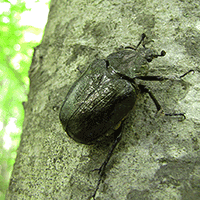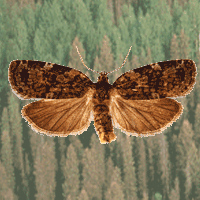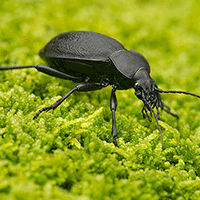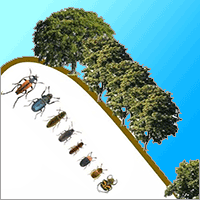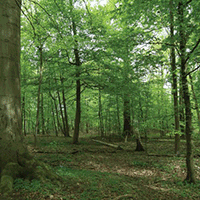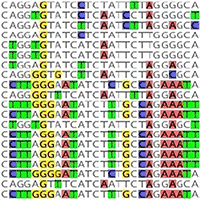
Identification of the ambrosia beetle Anisandrus dispar (Fabricius) (Coleoptera Curculionidae Scolytinae) using TaqMan™ probe assay on biological samples
Domenico Rizzo (1), Andrea D’Agostino (2), Igor Stabile (2), Chiara Ranaldi (2), Andrea Marrucci (2), Claudia Gabriela Zubieta (2), Daniele Da Lio (2), Linda Bartolini (1), Fabrizio Pennacchio (3), Elisabetta Rossi (2), Antonio P Garonna (4)
iForest - Biogeosciences and Forestry, Volume 16, Issue 3, Pages 182-187 (2023)
doi: https://doi.org/10.3832/ifor4287-016
Published: Jun 30, 2023 - Copyright © 2023 SISEF
Research Articles
Abstract
The European shot-hole borer Anisandrus dispar (Fabricius) (Coleoptera Curculionidae Scolytinae) is a well-known ambrosia beetle living on shrubs and several ornamental and fruiting trees where it can cause heavy damages. Like other harmful xyleborine species, A. dispar can represent a potential threat outside its native region. Molecular diagnostic tools can lead to accurate identification of xylophagous species hidden in wooden matrix in phytosanitary surveys at entry points. A molecular assay based on qPCR TaqMan™ Probes was developed for the identification of A. dispar from different matrices. To setup and perform the test, DNA extraction was carried out from adults, larvae, and artificial samples of wood chips from oak healthy plants whose lysates were contaminated with a known amount of DNA of A. dispar adults. The assay has proven inclusive for A. dispar, and exclusive towards the non-target organisms, showing 100% analytical specificity. The limit of detection was 0.32 pg µL-1 for the samples of insect adult DNA of A. dispar, and at 0.8 pg µL-1 for the samples containing lysates of Quercus spp. and 0.1 ng µL-1 of A. dispar adult DNA. Repeatability and reproducibility showed low values independently from the matrix used for DNA extraction, confirming the possible use in diagnostics of biological samples even if not directly related to the presence of A. dispar developmental stages. The presented approach may be adjusted and applied for phytosanitary purposes to other quarantine pests and rapidly detect possible infestations in vegetal matrices globally traded.
Keywords
European Shot-hole Borer, Xyleborini, Quarantine Species, Molecular Diagnostics, Biological Traces
Authors’ Info
Authors’ address
Linda Bartolini
Laboratory of Phytopathological Diagnostics and Molecular Biology, Plant Protection Service of Tuscany, v. Ciliegiole 99, I-51100 Pistoia (Italy)
Igor Stabile
Chiara Ranaldi
Andrea Marrucci
Claudia Gabriela Zubieta
Daniele Da Lio 0000-0002-9222-9501
Elisabetta Rossi 0000-0002-6073-1046
Department of Agricultural, Food and Agro-Environmental Sciences, University of Pisa, v. del Borghetto 80, I-56124 Pisa (Italy)
CREA - Research Centre for Plant Protection and Certification, v. Lanciola 12/A, I-50125 Florence (Italy)
Department of Agricultural Sciences, University of Naples “Federico II”, v. Università 100, I-80055 Portici (Italy)
Corresponding author
Paper Info
Citation
Rizzo D, D’Agostino A, Stabile I, Ranaldi C, Marrucci A, Zubieta CG, Da Lio D, Bartolini L, Pennacchio F, Rossi E, Garonna AP (2023). Identification of the ambrosia beetle Anisandrus dispar (Fabricius) (Coleoptera Curculionidae Scolytinae) using TaqMan™ probe assay on biological samples. iForest 16: 182-187. - doi: 10.3832/ifor4287-016
Academic Editor
Matteo Marchioro
Paper history
Received: Dec 09, 2022
Accepted: Mar 28, 2023
First online: Jun 30, 2023
Publication Date: Jun 30, 2023
Publication Time: 3.13 months
Copyright Information
© SISEF - The Italian Society of Silviculture and Forest Ecology 2023
Open Access
This article is distributed under the terms of the Creative Commons Attribution-Non Commercial 4.0 International (https://creativecommons.org/licenses/by-nc/4.0/), which permits unrestricted use, distribution, and reproduction in any medium, provided you give appropriate credit to the original author(s) and the source, provide a link to the Creative Commons license, and indicate if changes were made.
Web Metrics
Breakdown by View Type
Article Usage
Total Article Views: 20216
(from publication date up to now)
Breakdown by View Type
HTML Page Views: 15798
Abstract Page Views: 2570
PDF Downloads: 1512
Citation/Reference Downloads: 3
XML Downloads: 333
Web Metrics
Days since publication: 902
Overall contacts: 20216
Avg. contacts per week: 156.89
Citation Metrics
Article Citations
Article citations are based on data periodically collected from the Clarivate Web of Science web site
(last update: Mar 2025)
(No citations were found up to date. Please come back later)
Publication Metrics
by Dimensions ©
Articles citing this article
List of the papers citing this article based on CrossRef Cited-by.
References
The essential role of taxonomic expertise in the creation of DNA databases for the identification and delimitation of Southeast Asian ambrosia beetle species (Curculionidae: Scolytinae: Xyleborini). Frontiers in Ecology and Evolution 8: 27.
CrossRef | Gscholar
Molecular identification of an invasive wood-boring insect Lyctus brunneus (Coleoptera: Bostrichidae: Lyctinae) using frass by loop-mediated isothermal amplification and nested PCR assays. Journal of Economic Entomology 109 (3): 1410-1414.
CrossRef | Gscholar
A key for the identification of larvae of Anoplophora chinensis, Anoplophora glabripennis and Psacothea hilaris (Coleoptera Cerambycidae Lamiinae) in Europe. REDIA - Journal of Zoology 95: 57-65.
Gscholar
Identification of the red-necked longhorn beetle Aromia bungii (Faldermann, 1835) (Coleoptera: Cerambycidae) with Real-Time PCR on frass. Sustainability 12: 6041.
CrossRef | Gscholar
Molecular identification of Anoplophora glabripennis (Coleoptera: Cerambycidae) from frass by loop-mediated isothermal amplification. Journal of Economic Entomology 113 (6): 2911-2919.
CrossRef | Gscholar
A duplex real-time PCR with probe for simultaneous detection of Geosmithia morbida and its vector Pityophthorus juglandis. PLoS One 15 (10): e0241109.
CrossRef | Gscholar
TaqMan probe assays on different biological samples for the identification of three ambrosia beetle species, Xylosandrus compactus (Eichoff), X. crassiusculus (Motschulsky) and X. germanus (Blandford) (Coleoptera Curculionidae Scolytinae). 3 Biotech 11: 259.
CrossRef | Gscholar
Molecular identification of Anoplophora glabripennis (Coleoptera: Cerambycidae) and detection from frass samples based on real-time quantitative PCR. Journal of Plant Diseases and Protection 128: 1587-1601.
CrossRef | Gscholar
A catalog of Scolytinae and Platypotidae (Coleoptera). Part 2: Taxonomic Index, Volume A. Great Basin Naturalist Memories, pp. 1-833.
Gscholar
Identification of wood-boring beetles (Cerambycidae and Buprestidae) intercepted in trade associated solid wood packaging material using DNA barcoding and morphology. Scientific Reports 7: 40316.
CrossRef | Gscholar



